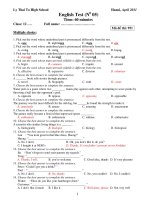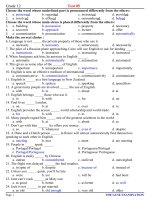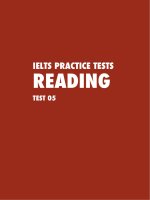Test 05 1 Test 05 1 Test 05 1 Test 05 1 Test 05 1 Test 05 1 Test 05 1
Bạn đang xem bản rút gọn của tài liệu. Xem và tải ngay bản đầy đủ của tài liệu tại đây (33.52 KB, 6 trang )
GRE Real 19
Test 5
SECTION 1
Time— 30 minutes
38 Questions
Directions: Each sentence below has one or two
blanks, each blank indicating that something has
been omitted. Beneath the sentence are five lettered
words or sets of words. Choose the word or set of
words for each blank that best fits the meaning of
the sentence as a whole.
4. As is often the case with collections of lectures
by ------- authors, the book as a whole is -------,
although the individual contributions are
outstanding in themselves.
(A)
(B)
(C)
(D)
(E)
1. Paradoxically, England's colonization of North
America was ------- by its success; the increasing
prosperity of the colonies diminished their
dependence upon, and hence their loyalty to their
home country.
(A)
(B)
(C)
(D)
(E)
5. Although some consider forcefulness and ------to be two traits desirable to the same degree,
I think that making a violent effort is much less
useful than maintaining a steady one.
demonstrated
determined
altered
undermined
distinguished
(A)
(B)
(C)
(D)
(E)
2. Although Harry Stank Sullivan is one of the most
influential social scientists of this century, his
ideas are now so ------- in our society that they
seem almost -------.
(A)
(B)
(C)
(D)
(E)
promptness
persistence
aggression
skillfulness
lucidity
6. The popularity of pseudoscience and quack
medicines in the nineteenth century suggests that
people were very -------, but the gullibility of the
public today makes citizens of yesterday look
like hard-nosed -------.
novel. .antiquated
revolutionary. .fundamental
commonplace. .banal
disputed. .esoteric
obscure. .familiar
3. Her first concert appearance was disappointingly
perfunctory and derivative rather than the ------performance in the ------- style we had anticipated.
(A)
(B)
(C)
(D)
(E)
different. .disconnected
incompetent. .abysmal
famous. .systematic
mediocre. .unexciting
various. .coherent
(A)
(B)
(C)
(D)
(E)
cautious. .educators
sophisticated. .realists
rational. .pragmatists
naive. .idealists
credulous. .skeptics
7. Though extremely ------- about his own plans,
the man allowed his associates no such privacy
and was constantly ------- information about
what they intended to do next.
talented. .tenuous
prosaic. .classic
artistic. .mechanical
inspired. .innovative
literal. .enlightened
(A)
(B)
(C)
(D)
(E)
idiosyncratic. .altering
guarded. .eschewing
candid. .uncovering
reticent. .soliciting
fastidious. .ruining
GO ON TO THE NEXT PAGE.
49
For more material and information, please visit www.tailieuduhoc
최영범esoterica어학원
Directions: In each of the following questions,
a related pair of words or phrases is followed by
five lettered pairs of words or phrases. Select the
lettered pair that best expresses a relationship
similar to that expressed in the original pair.
12. SHIFTLESS : AMBITION ::
(A) ingenuous : guile
(B) inert : composure
(C) redundant : repetition
(D) comic : laughter
(E) methodical : detail
8. FOLDER : PAPERS ::
(A) drawer : clothing
(B) recipe : ingredients
(C) cubicle : partitions
(D) suitcase : luggage
(E) box : lid
13. HISS : SIBILANT ::
(A) staccato : regular
(B) moan : stressful
(C) yell : sensible
(D) drone : monotonous
(E) screech : nonverbal
9. PROSE : PARAGRAPH ::
(A) drama : role
(B) message : code
(C) fiction : narrator
(D) poetry : stanza
(E) epic : lyric
14. FANATIC : ADMIRER ::
(A) patient : doctor
(B) opponent : challenger
(C) connoisseur : enthusiast
(D) detractor : advocate
(E) zealot : adherent
10. SPLINT : IMMOBILIZE ::
(A) duct : convey
(B) bolt : twist
(C) lid : screw
(D) canopy : expose
(E) ruler : fit
15. FLUENT : GLIB ::
(A) meticulous : finicky
(B) dedicated : steadfast
(C) humorous : wry
(D) miserly : altruistic
(E) wise : impartial
11. TACKINESS : ADHESIVE ::
(A) temperature : thermometer
(B) porosity : rock
(C) opacity : solution
(D) propulsion : sled
(E) sharpness : scalpel
16. COVETOUS : DESIRE ::
(A) reticent : confide
(B) prodigal : spend
(C) stoical : rage
(D) fretful : despair
(E) tolerant : judge
GO ON TO THE NEXT PAGE.
50
For more material and information, please visit www.tailieuduhoc
GRE Real 19
Directions: Each passage in this group is followed by questions based on its content. After reading a passage, choose
the best answer to each questions. Answer all questions following a passage on the basis of what is stated or implied
in that passage.
Defenders of special protective labor legislation for
women often maintain that elimination such laws would
destroy the fruits of a century long struggle for the
Line protection of women workers. Even a brief examination of
(5) the historic practice of courts and employers would show
that the fruit of such laws has been bitter: they are, in
practice, more of a curse than a blessing.
Sex-defined protective laws have often been based on
stereotypical assumptions concerning women's needs and
(10) abilities and employers have frequently used them as legal
excuses for discriminating against women. After the
Second World War, for example, business and government sought to persuade women to vacate jobs in
factories, thus making room in the labor force for re(15) turning veterans. The revival or passage of state laws
limiting the daily or weekly work hours of women
conveniently accomplished this. Employers had only to
declare that overtime hours were a necessary condition of
employment or promotion in their factory and women
(20) could be quite legally fired, refused jobs, or kept at low
wage levels, all in the name of "protecting" their health.
By validating such laws when they are challenged by
lawsuits, the courts have colluded over the years in
establishing different less advantageous employment
(25) terms for women than for men, thus reducing women's
competitiveness on the job market. At the same time, even
the same the most well-intentioned lawmakers, courts, and
employers have often been blind to the real needs of
women. The lawmakers and the courts continue to permit
(30) employers to offer employee health insurance plans that
cover all known human medical disabilities except those
relating to pregnancy and childbirth.
Finally, labor laws protecting only special groups are
often ineffective at protecting the workers who are
(35) actually in the workplace. Some chemicals, for example,
pose reproductive risks for women of childbearing years.
manufactures using the chemicals comply with laws
protecting women against these hazards by refusing to
hire them. Thus the sex-defined legislation protects the
(40) hypothetical female worker but has no effect whatever on
the safety of any actual employee. The health risks to
male employees in such industries cannot be negligible,
since chemicals toxic enough to cause birth defects in
fetuses or sterility in women are presumably harmful to
(45) the human metabolism. Protective laws aimed at changing
production materials or techniques in order to reduce such
hazards would benefit all employees without discriminating against anyone.
In sum protective labor laws for women are
(50) discriminatory and do not meet their intended purpose.
Legislators should recognize that women are in the work
force to support and that their needs— good health care, a
decent wage, and a safe workplace— are the needs of all
51
For more material and information, please visit www.tailieuduhoc
workers. Laws that ignore these facts violate women's
rights for equal protection in employment
17. According to the author, which of the following
resulted from the passage or revival of state laws
limiting the work hours of women workers
(A) Women workers were compelled to leave
their jobs in factories.
(B) Many employers had difficulty in providing
jobs for returning veterans.
(C) Many employers found it hard to attract
women workers.
(D) The health of most women factory workers
improved.
(E) Employment practices that addressed the
real needs of women workers became
common.
18. The author places the word "protecting'' in
quotation marks in line 21 most likely in order to
suggest that
(A) she is quoting the wording of the laws in
question
(B) the protective nature of the laws in
question should not be overlooked
(C) protecting the health of workers is
important to those who support protective
labor laws
(D) the laws in question were really used to the
detriment of women workers, despite being
overly protective in intent
(E) the health of workers is not in need of protection
even in jobs where many hours of overtime
work are required
최영범esoterica어학원
19. The passage suggests that which of the following
is a shortcoming of protective labor laws that
single out a particular group of workers for
protection?
(A) Such laws are open too weak to be
effective at protecting the group in question.
(B) Such laws are usually drafted by legislators who do not have the best interests of
workers at heart.
(C) Such laws exert no pressure on employers
to eliminate hazards in the workplace.
(D) Compliance with such laws is often costly for
employers and provokes lawsuits by
employees claiming discrimination.
(E) Employer compliance with such laws
results in increased tension among workers
on the job, because such laws unfairly
privilege one group of employees over
another.
20. According to the first paragraph of the passage,
the author considers which of the following to
be most helpful in determining the value of
special protective labor legislation for women?
(A) They cover all the common medical
conditions affecting men, but only some of
those affecting women
(B) They lack the special provisions for women
workers that proposed special labor laws
for women would provide
(C) They pay the medical costs associated with
pregnancy and childbirth only for the
spouses of male employees, not for female
employees
(D) They meet minimum legal requirements.
but do not adequately safeguard the health
of either male or female employees
(E) They have recently been Improved as a
result of the passage of new labor laws, but
continue to exclude coverage of certain
uncommon medical conditions affecting
women
23. According to the passage, special labor laws
protecting women workers tend generally to
have which of the following effects?
(A) A comparative study of patterns of workrelated illnesses in states that had such
laws and in states that did not
(B) An estimate of how many women workers
are in favor of such laws
(C) An analysis of the cost to employers of
complying with such laws
(D) A consideration of what intentions the
advocates of such laws really had
concerning women workers.
(E) An examination of the actual effects that
such laws have had in the past on women
workers
21. The main point of the passage is that special
protective labor laws for women workers are
(A) unnecessary because most workers are
well protected by existing labor laws
(B) harmful to the economic interests of
women workers while offering them little
or no actual protection
(C) not worth preserving even though they do
represent a hard-won legacy of the labor
movement
(D) controversial because male workers
receive less protection than they require
(E) inadequate in that they often do not
prevent employers from exposing women
workers to many health hazards
52
For more material and information, please visit www.tailieuduhoc
22. The author implies that which of the following is
characteristic of many employee health insurance
plans'?
(A) They tend to modify the stereotypes
employees often hold concerning women
(B) They increase the advantage to employers
of hiring men instead of women making it
less likely that women will be hired
(C) They decrease the likelihood that employers will offer more protection to women
workers than that which is absolutely
required by law
(D) They increase the tendency of employers to
deny health insurance and disability plans
to women workers
(E) They have little of any kind on women
workers, since typically very few women
are employed in those classes of jobs
covered by the laws
GO ON TO THE NEXT PAGE.
GRE Real 19
While it is true that living organisms are profoundly affected by their environment, it is equally
important to remember that many organisms are also
Line capable of altering their habitat significantly, some(5) times limiting their own growth. The influence of the
biological component of an ecosystem is often greater in fresh waters than in marine or terrestrial systems, because of the small size of many freshwater
bodies. Many of the important effects of organisms
(10) are related to their physiology, especially growth and
respiration. By their growth many species can deplete essential nutrients within the system, thus limiting
their own growth or that of other species. Lund has
demonstrated that in Lake Windermere the algae
(15) Asterionella is unable to grow in conditions that it
itself has created. Once a year, in the spring, this
plant starts to grow rapidly in the lake, using up so
much silica from the water that by late spring there is
no longer enough to maintain its oval growth. The
population decreases dramatically as a result.
24. Which of the following is an example of the
type of organism described in lines 2-5?
(A) A kind of ant that feeds on the sweet juice
exuded by the twigs of a species of thorn
tree that grow in dry areas
(B) A kind of fish that, after growing to
maturity in the ocean, return to fresh water
(C) A kind of flower that has markings
distinctly perceptible in ultraviolet
light to the species of bee that pollinates the
flowers
(D) A kind of tree with seeds that germinate
readily only in a sunny spot and then
develop into mature trees that shade the
area below them
(E) A kind of butterfly, itself nonpoisonous,
with the same markings as a kind of
butterfly that birds refuse tomcat because it
is poisonous
25. It can be inferred from the passage that which of
the following is true about Asterioncella plants
in Lake Windermere?
(A) They are not present except in early spring
(B) They contribute silica to the waters as they
grow
(C) They are food for other organisms
(D) They form a silica-rich layer on the lake bottom
(E) Their growth peaks in the spring
26. The passage indicates that organisms frequently
have the strongest effects on their environment in
(A) oceans, since oceans contain the largest
organisms living on Earth
(B) oceans, since oceans provide habitats for
many different kinds of species
(C) freshwater bodies, since such effects become
pronounced in relatively small spaces
(D) fresh water lakes, since nutrients in freshwater
lakes are present only in small amounts
(E) land area, since there exist major influences of
climate on the kinds of small organisms
supported in land areas
27. The primary topic of the passage is the way in
which
(A) organisms are affected by the amount of
nutrients available
(B) organisms can change their own surroundings
(C) elements of freshwater habitats impede the
growth of small organisms
(D) the reproduction of organisms is controlled
by factors in the environment
(E) plant matter in a given local can increase up
to a limit
GO ON TO THE NEXT PAGE.
53
For more material and information, please visit www.tailieuduhoc
최영범esoterica어학원
Directions: Each question below consists of a word
printed in capital letters, followed by five lettered
words or phrases. Choose the lettered word or
phrase that is most nearly opposite in meaning to
the word in capital letters.
33. SHOAL :
(A) refined
(B) straight
(C) deep
(D) secure
(E) simple
Since some of the questions require you to
distinguish fine shades of meaning, be sure to
consider all the choices before deciding which
one is best.
34. BAWDY :
(A) decorous
(B) ridiculous
(C) soulful
(D) reliable
(E) poignant
28. STAGNANT :
(A) towering
(B) drenched
(C) flowing
(D) soft
(E) contained
35. BADINAGE :
(A) literal translation
(B) clear reference
(C) serious conversation
(D) detailed description
(E) ardent supporter
29. ALLUDE :
(A) mention explicitly
(B) request insistently
(C) prepare carefully
(D) speak slowly
(E) regret deeply
36. MARTINET :
(A) unskilled laborer
(B) indulgent individual
(C) malicious opponent
(D) reliable agent
(E) ardent supporter
30. HAVOC :
(A) serenity
(B) refuge
(C) destitution
(D) apex
(E) contemplation
37. EMBOLDEN :
(A) lop
(B) cow
(C) warp
(D) demote.
(E) defraud
31. REPRESS :
(A) review
(B) foster
(C) extol
(D) salvage
(E) exhaust
38. ESTRANGEMENT :
(A) rapprochement
(B) familiarization
(C) equanimity
(D) nonchalance
(E) recompense
32. UTTER :
(A) skewed
(B) valid
(C) concrete
(D) partial
(E) direct
IF YOU FINISH BEFORE TIME IS CALLED, YOU MAY CHECK YOUR WORK ON THIS SECTION ONLY.
DO NOT TURN TO ANY OTHER SECTION IN THE TEST.
54
For more material and information, please visit www.tailieuduhoc









